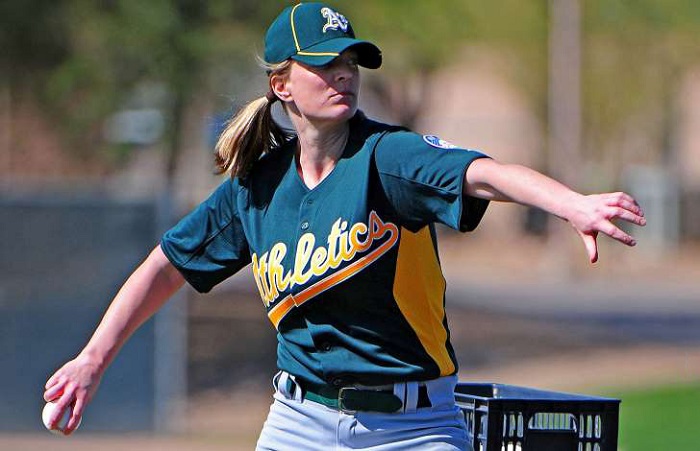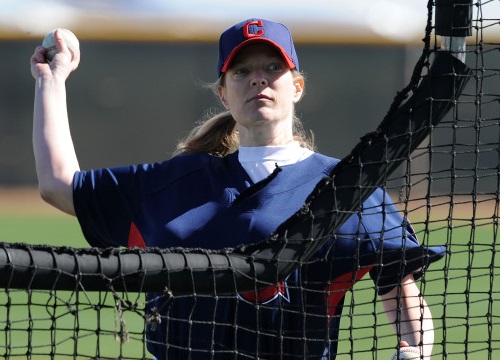On September 28, 2015, Justine Siegal made baseball history when she was offered and accepted a coaching position with the Oakland Athletics making her the first female coach in Major League Baseball history. Siegal took the position of guest instructor of the Athletics Fall Instructional League which ran from October 4–17.
Her signing might have been seen by some as a publicity stunt by Athletics Executive Vice President of Baseball Operations Billy Beane. However, there is much more to the Justine Siegel story than publicity. Now 40 years of age, with a 17-year old daughter, she has devoted her lifetime to her daughter and to baseball.
Siegal grew up an Indians fan living in Cleveland Heights, Ohio. She says she started playing the game as a five-year old and continued as long as she could regardless of gender bias barricades.
“I have been doing it my whole life and I just always loved the game and I wanted to keep playing. When I was about 13, I was told it was time to go over to softball – that is what girls did. But I decided to ignore that first coach and a line of many others, because I really loved baseball. And I did not see any reason why I should quit,” she said.

Oakland A’s coach Justine Siegal
(Photo credit – Kyle Terada)
As a teenager Siegal continued to play in community baseball leagues although it was sometimes a challenge to find coaches who would let her play.
“I did play for my high school, so I had a good experience with my high school, but it was not always easy. But when you love something you go after it,” she said.
From that time on Justine Siegal has been following her dream and breaking down gender barriers preparing the way for young baseball players, especially girls.
In 2007 she became college baseball’s only female assistant coach when she started a three year stint as a pitching coach with Springfield College in the northeast of Massachusetts. Her duites included pitching batting practice for three years.
Siegal made further baseball history in 2009 as she became the first woman to coach first base in professional baseball when she joined the Brockton Rox, an independent league team in the Boston area.
While pursuing her baseball interests Justine Siegal also pursued her other baseball related interests. She has a PhD in Sport and Exercise Psychology from Springfield College in Massachusetts with an academic focus on performance enhancement, sport management, coaching, gender equity, and youth sports. She had received her MA In Sports Studies at Kent State University in Ohio.
Part of her reason for pursuing her doctorate may well have been motivated by her baseball coach as a teenager. “I was 16 when I told my coach I wanted to be a college baseball coach,” Siegal said. “He laughed at me and said a man would never listen to a woman on a baseball field. That’s when I decided I was going to get a Ph.D., prove them wrong.”
In 2011 she decided to follow her dream of pitching batting practice to a MLB team. She wrote a letter to every MLB team inquiring about the possibility of pitching batting practice during spring training. She received a reply from both the Cleveland Indians and Oakland Athletics indicating a willingness to give her the opportunity to pitch batting practice.
On February 21, 2011 Justine Siegal threw batting practice to the Cleveland Indians, the first female to ever do so.
“If you didn’t see the ponytails, she would have fit right in,” said catcher Paul Phillips, one of the players who took swings off Siegal’s pitches. “She did great.”
Phillips teased that he wanted to tell her she threw like a girl – but she didn’t. Before Spring Training was finished she would also pitch to the Athletics, Rays, Cardinals, Astros and Mets.
“The idea behind throwing batting practice to big-league players is to encourage girls to play baseball. I want girls’ baseball across America,” Siegal said, “When I throw, all of a sudden we have a dialogue about how much girls and women love baseball and how they want to be a part of it.”

Siegal made history on February 21, 2011 when she became the first female in MLB history to throw batting practice to the Cleveland Indians during spring training. She did so again on September 28, 2015 when she was hired as a coach by the Oakland A’s.
(Photo credit – Norm Hall)
She wore jersey number 15 because her daughter, Jasmine, was born on February 15. On the sleeve of the jersey was Christina Taylor Green’s Little League patch. Green was killed during a shooting spree in Tucson, Ariz., on January 8 in which U.S. Representative Gabrielle Giffords was shot in the head.
“I asked a league organizer if it was OK if I wore her patch,” said Siegal. “They said ‘please do.’ Christina Taylor Green was the only girl on her baseball team. My organization ‘Baseball For All’ is all about providing opportunities for girls to play baseball. Most of them are the only girl in their league. I’m really honored to wear this patch.”
That brings us back to her coaching role with the Athletics in the Fall Instructional League. Grateful for the opportunity Siegal was willing to do whatever needed to be done: “ I’m going to Instructional League and spending two weeks working with a mixture of 40 or so minor leaguers there to put in extra work. I’m a rookie coach, so I’m there to be of service. I’m happy to do whatever they need — hitting ground balls, grabbing water, helping with batting practice, and I’ll be doing some classroom work. The A’s mix in some classroom work with their training so I will use my PhD as well.”
The chance to work as the first MLB female coach fulfilled a dream for Justine Siegal. That is, to be a major leaguer. The Athletics made no further commitments to her so she doesn’t know what the future will bring.
In the meantime Justine Siegal is the Director of Sports Partnerships at the Center for the Study of Sport in Society at Northeastern University where she is responsible for cultivating relationships for academic program expansion, as well as enhancing existing relationships with Major League Baseball and other professional sports organizations.
Additionally she is the founder and executive director of Baseball for All , an organization that provides meaningful opportunities and instruction in baseball, especially for girls.
She knows that there will be female coaches in MLB just as there are now in other professional sports and perhaps she will be the first full time coach. She has some advice for those striving to become part of baseball’s professional coaching ranks: “All of these women know that they are trailblazers, and that their role is just so much more important than just what they are doing.”
“Every step I made, I knew that there was a teenage kid behind me looking to see if this was possible, and so I was very careful with how I reacted to everything,” she says. “I knew my mission was bigger than just me.”




 March 5th, 2016 at 6:00 am
March 5th, 2016 at 6:00 am  by Harold Uhlman
by Harold Uhlman  Posted in
Posted in 

I vividly recall when Justine threw BP for the Indians at Goodyear Ballpark during spring training 2011. I remember thinking at the time “Good for her” and not once thought of it as a publicity stunt.
I checked up on her a few times after that and saw that she had also thrown spring training BP for a couple other teams that spring but heard nothing more about her after that and had completely forgotten about her – until this article.
Great work as usual, Harold. Thanks.
Good luck to her. I think this is a big step in someday a girl will make it to MLB.
You’re going to like part-4, Joe.
I would never advice a young girl to play baseball, over softball, because there is very few girls that can play baseball, when they get older. There might be that one girl, that could make it at baseball, at an higher level, but that is only one, or very few. Once girls get out of elementary school, the boys start being physically stronger then girls, and that will always be that way, so girls should stick with softball, where they can play as they get older. This doesn’t mean a woman can’t be a good baseball coach, as long as she is familar to the game of baseball.
Justine when asked if she thought a female will ever play MLB baseball acknowledged how daunting the task really is. She felt if it is ever to happen it will be with a knuckle ball pitcher.
I don’t think Justine is making a case for females playing MLB. She is making the case that girls can play baseball and at a fairly high level just because it is a good game to play and they can do it. Her mission is to encourage them to play which is the focus for her Baseball for All program. The further a woman goes in the game the better the dialogue about girls playing baseball. Forty per cent of baseball fans attending games are females if I read it correctly.